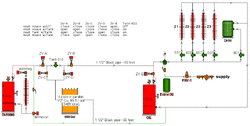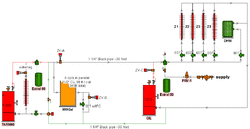SteveJ said:
Very cool to see yet another custom embedded arm controller... I think nofossil has started a revolution!!
Plumbing questions
1. Does the Tarm have a built in circulator? If not, I think you need a pump between the termovar and the Tarm to get flow.
2. Why did you chose to have the zone valves and circs in the supply line instead of the return line? The old argument is that everything lasts longer in the cool side...
3. I assume all the zv are normally closed. Is the automag loop heat load large enough to handle a full load from the Tarm if the controller goes out?
Geek stuff (about the controls)
1. I would like to see your controller code if you don't mind - curious about the timing and polling, etc.
2. Are you using the TS-7260, TS-9700, DIO-64 similar to nofossil?
3. How many power supplies and relays are you up to?
4. What voltages are you running?
5. What is your fail-safe mode if the arm goes down?
Great stuff - do you have logging and will you post charts like nofossil?
Thanks for the inputs, I think my new design handles your 1st 2 points. For the 3rd, I still need to research the sizing on the overheat loop.
Geek stuff:
1 - I would be happy to share my code, but at this point I have only written a utility in C to read the digital temp sensors. I did that a while ago because that was the only part I was unsure of and I wanted to make sure it would be do-able. The timings are a little tricky and I used a system call to turn off the kernel's task scheduling while the program is running so that some other task would not get some cpu time and screw up the timings. The utility is currently on a hard drive inside my old computer which is not hooked up.. I'll post it when I get the HD out and connected to my new comupter. For the rest of my code I am probably going to use C to write a utility that will send signals to the relays, then write the rest of the code to manage the whole system in Perl. I am going to finish up the plumbing then move onto the controls, so I'll probably be finishing just in time for heating season.
2 - I am using a ts7800 and i am using it's own DIOs. My plan is to use the ts7800 to control some small relays which will then control the relays on a taco relay board.
3 - I haven't totally thought this through yet because I have been focused on my tank, chimney, and plumbing so far but I think I am going to use my existing 6 zone taco relay board and PS for my zones, then maybe another similar board for the rest of the stuff. Depending on the plumbing design I decide on, I think I may only need a few more relays. Then, for each 24V relay I will use corresponding smaller relays inside the ts7800 case.
4 - Which voltages are you asking about here?
5 - Well, not totally ironed out yet, but with the current design, the normal state is that either the Tarm or tank can heart the house. Then, inside my Arm board, I am going to wire small manual 3 pole switches in series with the 3 pole relays, so that I can always manually override whatever state each relay is in.
Yes I will definitely have logging, which is one of the main reasons I liked the idea of using something with more power than necessary, like the arm. Eventually I would like to do cool stuff like be able to turn on my future snow melt zone from the web while at work, use the arm to also control my future irrigation system and pull weather forecast data from the noaa web service so that I can keep the water turned off when rain is in the forecast, etc, etc.
Marc



